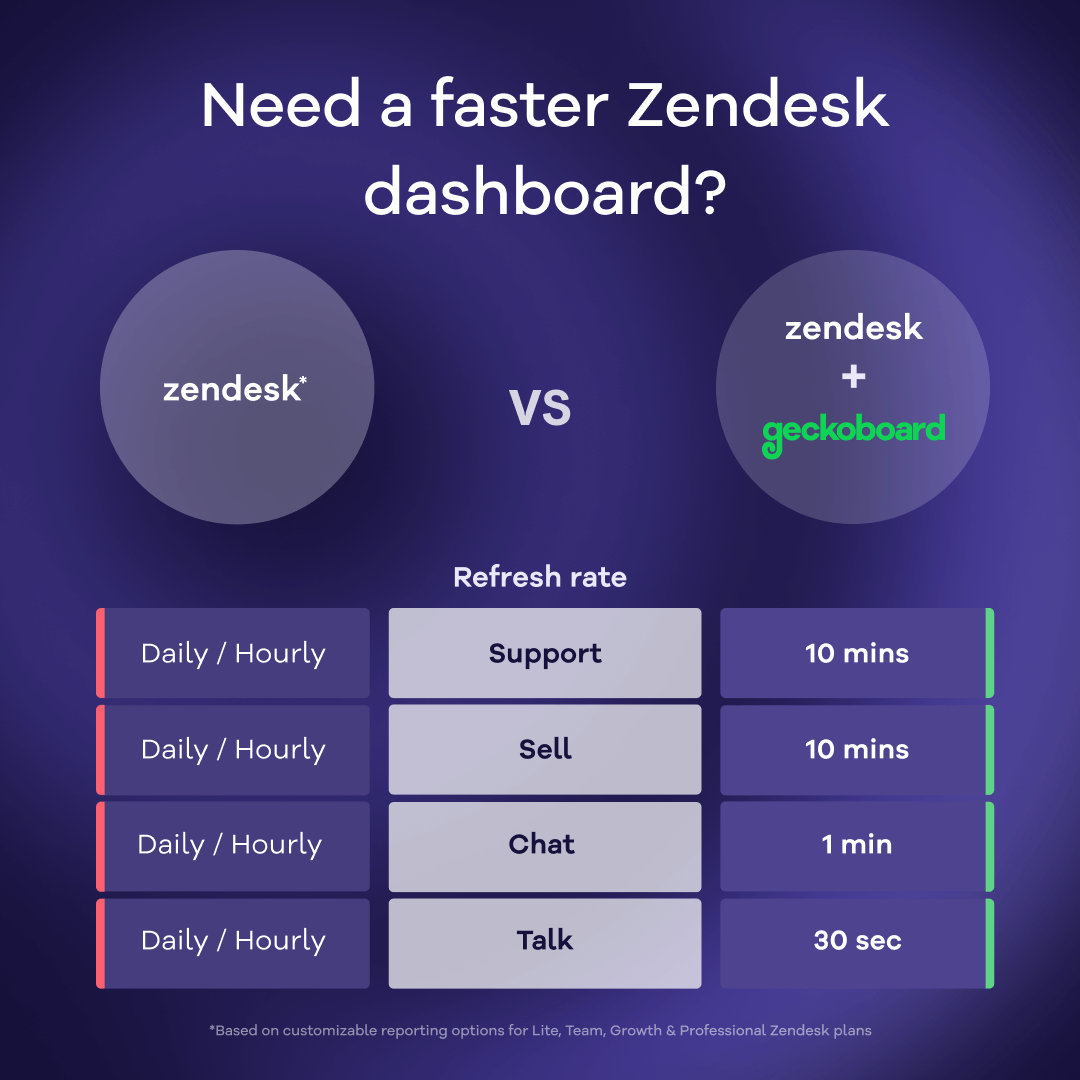Editor’s Note: Zendesk updated their pricing effective July 12, 2023. This post includes the updated pricing to help you make the best decision for your support team.
Could you save money on your Zendesk Plan?
Zendesk is often the go-to choice for businesses seeking a robust customer support tool. But navigating their extensive range of plans and pricing options can feel overwhelming.
Don’t worry—we’ve got you covered.
In this guide, we’ll unravel Zendesk's pricing plans to help you understand how they match up against your team’s needs. We'll help you understand which Zendesk tier works for different kinds of organizations.
We’ll also provide some practical tips to help you save money on your Zendesk plan. Including how a real-time KPI dashboard from Geckoboard could help you reduce some of your reliance on Zendesk and potentially save you thousands of dollars in the process.

How do I choose the right Zendesk plan?
In today's economy, companies everywhere are diligently seeking ways to reduce costs and optimize their overall efficiency.
Since the support helpdesk is often one of the largest software costs for support teams, choosing the right Zendesk pricing tier becomes a crucial consideration. How can you meet your business needs without spending way more than you need to?
Let’s be clear: a well-structured ticketing system is immensely valuable for any support team. It’s the foundation of what you do. It’s how you track your work and measure your KPIs (key performance indicators).
It’s how you make sure customers get routed correctly and don’t slip through the cracks.
Zendesk's tiers are thoughtfully designed to cater to the different levels of support that organizations aim to provide. A brand-new ecommerce startup’s needs are wildly different from an established enterprise SaaS brand.
Asking the right questions
When you’re determining the right Zendesk plan for your organization, start by getting clear on your customers’ requirements and your internal needs.
Ask questions like these:
- What features are a must-have based on our support team’s structure?
- What channel(s) do our customers prefer?
- What contractual requirements are in place for our support team (such as Service Level Agreements)?
- What other internal systems might need to be integrated?
- What metrics or KPIs matter most to us?
As you’re working through these questions—or other similar ones—consider how you’d answer them now and how you might answer them differently in three years.
As your support organization evolves, your tooling needs change.
The last thing you want is to get locked into a plan that will require significant changes a year or two from now.
Understanding Zendesk’s pricing plans
At first glance of the Zendesk Suite’s pricing plans, you’ll notice a massive range of options.
From basic plans to several established tiers to custom enterprise plans, Zendesk has plans for businesses of all sizes.
The first question to ask is obvious: What’s the difference between a basic plan and a Zendesk Suite plan?
- Zendesk Support (the ‘basic plan’) focuses mostly on the ticketing components of Zendesk. It allows you to convert your support-related emails (and some social channels) into tickets.
- Zendesk Suite gives you way more options. If you want to build a help center, connect voice systems, or use chatbots on your website, then you probably need a Zendesk Suite plan.
Each plan’s pricing is based on the number of agents. Zendesk also recently introduced an Advanced AI add-on, which is available at an additional cost.
Lastly, you’ll see significant savings—up to 20%—by opting for an annual plan over a monthly subscription. If you’re looking to save money and you’re not planning to move away from Zendesk, switching to an annual subscription may be the quickest way to reduce your Zendesk costs.
Choosing the right Zendesk plan for your needs
Understanding the lay of the land is important, but ultimately it all comes down to one question: Which Zendesk plan is the right fit for your team’s needs?
Below, we’ll provide real-world examples to help you determine which Zendesk tier best suits your organization. It’s not always clear-cut, but by considering factors like company size, support needs, and priorities, you can confidently select a Zendesk plan that aligns well with your requirements.
The right Zendesk plan for a startup or small business with basic support needs
Every small business and startup hits a point where sending support emails or phone calls to the founders just doesn’t work anymore.
As your company grows, it’s challenging to keep track of all your customer conversations and to make sure that every question is properly addressed.
Frankly, it's not uncommon to start experiencing frustration, where valuable conversations seem to get lost in the overwhelming inbox.
If that sounds like you, you’re probably in need of a cost-effective solution that offers essential support features that will streamline your customer interactions. You don’t need to reinvent your digital experience—you just need a reliable system that can efficiently manage and organize conversations, ensuring that every customer gets the help they need.
Suitable Zendesk Tier: Support or Suite Team
These tiers offer basic ticketing systems, email support, and additional features like chat and standard bots. If you haven’t already implemented a help center for customer self-service, the Suite Team option provides this functionality.
Price:
- Zendesk Support Team is available at an annual cost of $19 per agent/month or a monthly cost of $25 per agent.
- Zendesk Suite Team is available at an annual cost of $55 per agent/month or a monthly cost of $69 per agent.
The best Zendesk plan for growing businesses with scaling support operations
As your organization grows, it's important to have the right tools in place to meet your customers’ evolving needs.
One crucial aspect for growing support teams is collecting metrics—such as Customer Satisfaction (CSAT)—to gauge how well you’re serving your customers. This data enables you to gain insights and continuously improve your support services.
On top of that, if you’re serving a global customer base, it's essential to provide support in multiple languages. Giving customer support in a customer’s own language helps make them more successful and shows you’re there for them.
Furthermore, you’ll probably benefit from having dynamic options on support forms. This enables you to gather specific and relevant information from customers based on the type of inquiry they have. By tailoring your support form, you streamline the support process and ensure you only collect the data you need to quickly resolve issues.
Suitable Zendesk Tier: Suite Growth
Zendesk’s Suite Growth plan offers features such as multiple ticket forms, light agents, SLAs, CSAT, multilingual support, and self-service customer portals to meet the growing demands of your business.
Price: Zendesk Suite Growth is priced at $89 per agent/month on an annual basis or $115 per agent/month on a monthly basis.
The best Zendesk plan for established businesses needing advanced customization and analytics
As you grow, it's natural to implement specialized support teams that provide expertise in different areas or to operate in a tiered support structure.
At this point, compliance often becomes a significant aspect of your operations.
Serving European customers brings unique considerations, as they may have specific requirements regarding the storage and handling of their data. You may also be dealing with sensitive health information and require a tool with HIPAA certification.
Complex support tickets often involve bringing in other internal users, but side conversations in Slack aren’t captured as part of the ticketing system. This can create challenges for management and other agents, as important information shared in those conversations might be missed. Zendesk’s Side Conversations solves this problem, enabling you to pull those comments directly into your Zendesk tickets.
Suitable Zendesk Tier: Suite Professional
Zendesk’s Suite Professional provides advanced features like custom analytics, side conversations, skills-based routing, integrated community forums, and HIPAA compliance. When an out-of-the-box tool doesn’t meet your needs anymore, Suite Professional offers a significantly higher level of customization within Zendesk.
Price: Zendesk Suite Professional costs $115 per agent/month if billed annually or $149 per agent/month if billed monthly.
Custom Zendesk plans for large enterprises with complex support needs
If you grow large enough, your organization might have really complex support requirements. A large global customer base, a complicated internal structure, and supporting several brands require a highly customizable support solution.
Suitable Zendesk Tier: Suite Enterprise
Suite Enterprise is Zendesk’s custom plan. It offers a comprehensive set of features, including a sandbox environment, AI-powered Content Cues to help you increase self-service, custom agent roles, and contextual workspaces to tailor your agents’ workspace based on specific workflows.
Price: Zendesk Suite Enterprise is priced at $169 per agent/month when billed annually or $219 per agent/month if billed monthly.
Note: If Suite Enterprise doesn’t include enough power or customization for you, Zendesk also offers their Suite Enterprise Plus, starting at $249 per agent/month.
How a KPI dashboard can save you money on Zendesk
Remember that not everyone who needs access to Zendesk data necessarily needs a costly Zendesk seat. By using Geckoboard, you can seamlessly communicate Zendesk KPIs with a wide range of colleagues, saving everyone time and money.
Geckoboard has been trusted by thousands of Zendesk customers, over the years, as a reliable and inexpensive way of communicating Zendesk data with a wide range of colleagues – via desktop, mobile, Slack or via TV dashboard set up in the office.
Geckoboard's interactive view also means that multiple users can investigate trends and dig into Zendesk data, without needing a Zendesk seat.

Another way Geckoboard can save you money on your Zendesk plan is by giving you access to real-time Zendesk data, without needing to upgrade your Zendesk plan to one that supports more regular refresh rates.
In fact, Geckoboard dashboards refresh more regularly (at least every 10 minutes) than most premium Zendesk Explore dashboards (which refresh hourly).

Other tips for saving money on your Zendesk spend
Here are a few other key tips for saving money on Zendesk:
- Start small. With all of Zendesk’s features, jumping straight in and opting for a high-cost plan can be tempting. Since Zendesk’s core functionality is ticket management, a better approach is often to start with a cheaper plan, implement it well, then upgrade when you really need to. If you’re currently in a higher-cost Zendesk tier and you’re not using the full functionality, downgrading to a simpler plan can bring significant savings.
- Focus on efficiency. Zendesk charges you based on the number of agents on your plan. This means that every time you deflect a ticket with helpful documentation, or make it easier for your team to handle more tickets in the same amount of time, you’re decreasing your need to purchase additional seats. If you can solve 8,000 tickets a month with 20 agents instead of 40 agents, you’ve just slashed your costs in half.
- Leverage light agents and side conversations. While you need to be on Suite Growth (for light agents) or Suite Professional (for side conversations), these two features can eliminate your need to add other internal team members as full agents in Zendesk.
- Consider alternatives. If you are really unable to make Zendesk work within your budget, you might consider popular alternatives such as Intercom or HubSpot.
Start saving money on your Zendesk plan today
Zendesk pricing can be complex, but by matching your plan to your company’s needs, you can be confident that you’re investing in a tool that’s a good fit for your business.
And by leveraging the tips above, you can also find ways to save money on your Zendesk plan without negatively impacting your customer experience.
And if you want to explore how a real-time dashboard can improve your Zendesk experience, check out Geckoboard. Within minutes, you’ll be able to build and launch real-time dashboards to keep your entire support team better informed.
Article written by Chris Broughton
Chris has worked in Technical Support and Consulting teams for over 15 years in the UK and Canada, most recently at Vidyard, where he helped implement and build out Zendesk. He’s a family man and an avid supporter of Liverpool and Wrexham football clubs.

